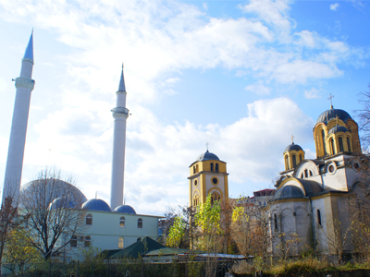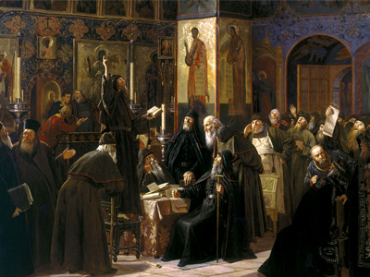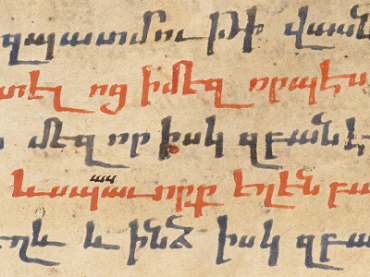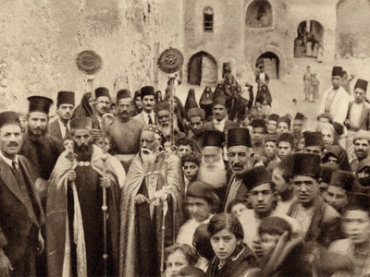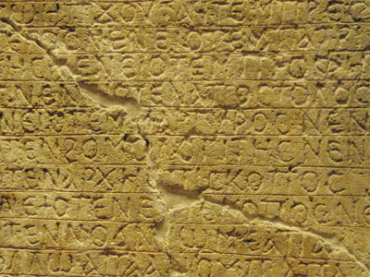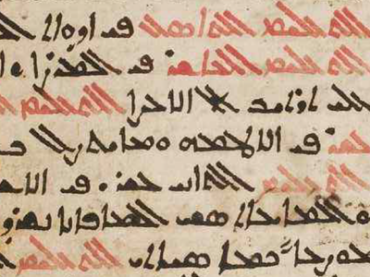Syriac and Eastern Christianity
Initial Woodbrooke Studies
Woodbrooke Studies 1
ISBN: 978-1-59333-832-9
The initial installments of Alphonse Mingana’s “Woodbrooke Studies: Christian Documents in Syriac, Arabic, and Garshūni, edited and translated with a critical apparatus,” began as articles within the Bulletin of the John Rylands Library Manchester, starting in volume 11. In this initial foray into publishing the manuscripts in his personal collection, Mingana offers translations and critical comments on seven documents: A Treatise of Barsalībi against the Melchites; Genuine and Apocryphal Works of Ignatius of Antioch; A New Jeremiah Apocryphon; A New Life of John the Baptist; Some Uncanonical Psalms; the Vision of Theophilus; and the Apocalypse of Peter.
$188.00
Das Sendschreiben des Patriarchen Barschuschan an den Catholicus der Armenier
The Circular Letter of the Patriarch Bar Shushan to the Catholicos of Armenia
By Otto Lichti
Series: Analecta Gorgiana 50
ISBN: 978-1-59333-865-7
This work provides the Syriac text, with a German introduction and translation, of John Bar Shushan’s treatise attacking the Melkite tradition, upholding the Creed of Faith, defending the Syrian Orthodox preparation of the Eucharist, and criticizing Armenian Church practices.
$48.00
Catalogue of All Works Known to Exist in the Armenian Language
Up to the Seventeenth Century
Series: Analecta Gorgiana 54
ISBN: 978-1-59333-869-5
This work provides a summary, short author biography, and reference to editions or translations of all the works of Armenian provenance known to the author. It concludes with works of Greek Church Fathers and secular literature preserved in Armenian.
$90.00
Mary and Joseph, and Other Dialogue Poems on Mary
Series: Texts from Christian Late Antiquity 8
ISBN: 978-1-59333-839-8
What was Joseph’s reaction when he arrived home to find Mary pregnant? How did Mary manage to persuade him that her child was none other than the Son of God? The Syriac literary tradition had a unique way of answering these sorts of questions raised by the Bible. Dialogue poems (sughyotho) offer lively, thought-provoking, and often delightful re-imaginings of Biblical events. They expand the Biblical stories, giving the familiar characters more dialogue and describing their inner thoughts. The collection provides five dialogue poems featuring Mary, in Syriac original with facing English translation.
$40.00
Assyrians in Yonkers
Reminiscences of a Community
ISBN: 978-1-59333-745-2
This book is Dr. Ameer’s reflection on growing up within the small community of Assyrian Christians in Yonkers, New York. He uses the year 1946 as an orientation for his discussion of that ethnic community, city, and time in history. The book enables readers to reflect on those aspects of community critical to civic support and on the process of successful assimilation in mid-twentieth century America. The author describes the experience of living in an ethnically, religiously, and racially diverse society. This will be of particular interest to people concerned with sustaining the idea of community in American life.
$96.00
Clement of Alexandria and the Beginnings of Christian Platonism
Series: Analecta Gorgiana 59
ISBN: 978-1-59333-874-9
Casey’s survey reveals not only his adept insights into Clement’s thought but also the great breadth of his knowledge of the Greek philosophers and the early Jewish and Christian theologians in the Roman Empire.
$45.00
The Acts of the Edessan Martyrs Guria and Shmona, and Habib and the Story of their Deliverance of Eu
ISBN: 978-1-59333-872-5
In this book the Syriac texts along with translations of the tales of the martyrs themselves as well as the miraculous deliverance of Euphemia are introduced by Professor Burkitt with a commentary focusing on the historicity of the different accounts.
$151.00
The Holy Spirit in the Syrian Baptismal Tradition
Series: Gorgias Eastern Christian Studies 12
ISBN: 978-1-59333-844-2
A sensitive and evocative treatment of the role of the Holy Spirit in worship. With a keen awareness of the tradition of Syrian Christianity, Brock begins his exploration with the role of the Holy Spirit in the Syriac Bible. A striking aspect of this tradition is the imagery used for the Spirit, including: compassionate mother, fire, olive oil, as well as the more common image of dove. Brock also summarizes commentaries and other literature on the baptismal rite, touching on Syriac literature and works translated from the Greek.
$137.00
Grammatik der neusyrische Sprache
am Urmia-See und in Kurdistan
Series: Kiraz Historical Grammars Archive 13
ISBN: 978-1-59333-835-0
This work of Theodor Nöldeke is an extremely rare find. Its scarcity should not be taken as a reflection on its authority or usefulness, however. In this original 1868 edition, Nöldeke lays out the basics of Neo-Syrian as it was used in Kurdistan and the area of Uremia. This valuable study, essentially unique to this day in its coverage of underrepresented language studies, provides a substantial, German introduction to the dialects described, followed by a thorough study of the languages themselves, also in German.
$196.00
Shmona, Guria and Habib Edessan Martyrs
Texts and Translations with Notes and Commentary
Series: Analecta Gorgiana 58
ISBN: 978-1-59333-873-2
In this book the Syriac texts along with translations of the tales of the martyrs are introduced by Professor Burkitt with a commentary focusing on the historicity of the different accounts.
$71.00
The Tale of Euphemia and the Goth
Text and Translation with Notes and Commentary
Series: Analecta Gorgiana 57
ISBN: 978-1-59333-876-3
This book provides the Syriac text along with a translation of the tale of Euphemia and the martyrs’ deliverance of her from the Goth.
$56.00
The Syriac-Arabic Glosses
Series: Kiraz Historical Dictionaries Archive 13
ISBN: 978-1-59333-834-3
This edition of the Syriac-Arabic glosses of Isho Bar Ali is a publication difficult to locate. These glosses are located in the second part of Bar Ali’s lexicon, as the first part had been previously published. Bar Ali, a physician as well as a lexicographer, produced this noted Syriac-Arabic dictionary showing the meanings of Syriac words in Arabic. This historic step in the development of Syriac lexicography is analyzed here according to the glosses of the numerous manuscripts cited in the forward.
$206.00
The Life of Severus by Zachariah of Mytilene
By Lena Ambjörn
Series: Texts from Christian Late Antiquity 9
ISBN: 978-1-59333-841-1
This biography of Severus, the patriarch of Antioch from 512-518 CE, attributed to his schoolmate Zachariah of Mytilene, gives unique information about life in Mediterranean region in the second half of the 5th century. These two young men from wealthy families became involved with a Christian movement, the "philoponoi," "those devoted to work" who combined asceticism with theological study. The work, originally in Greek, survives only in Syriac, which this volume presents alongside the first English translation of it. It is an important source for studies on Ancient Biography, Late Antiquity, and Early Christianity.
$44.00
Hugoye - Journal of Syriac Studies (Volume 10)
Edited by George Anton Kiraz
Series: Hugoye: Journal of Syriac Studies 10
ISBN: 978-1-59333-819-0
Widely regarded as a premier journal dedicated to the study of Syriac, Hugoye: Journal of Syriac Studies was established in 1998 as a venue devoted exclusively to the discipline. An organ of Beth Mardutho, the Syriac Institute, the journal appears semi-annually and will be printed in annual editions. A peer-reviewed journal, Hugoye is a respected academic source for up-to-date information about the state of Syriac studies and for discovering what is going on in the field. Contributors include some of the most respected names in the world of Syriac today. This is Volume 10 of the journal from 2007.
$75.00
Analecta Syriaca
Series: Kiraz Historical Grammars Archive 14
ISBN: 978-1-59333-959-3
A rare edition of Lagarde’s Syriac ephemera, this volume is a linguist’s delight. Introduced in Latin and Arabic, the descriptions and annotations to Syriac manuscripts that constitute this book will seldom be found elsewhere. The various Syriac codices included in the collection are presented in Syriac without translation. For the student of Syriac who is seeking the authentic experience of reading Syriac materials, this study will be a treasury of material. Over the decades, Legarde’s works have become increasingly difficult to locate, and Gorgias Press is pleased to be able to offer this collectable again.
$148.00
The Coptic Pentateuch and Arabic Gospels
ISBN: 978-1-59333-965-4
Written in the days when textual criticism was still relatively new, and the great mass of manuscripts commonly used by present-day biblical scholars had not yet been plumbed, Lagarde spent many years making these exotic manuscripts available to scholars who previously had no access to them. In this volume are combined two manuscripts: the Pentateuch translated into Coptic, and the Gospels translated into Arabic. Despite the relatively recent dates of the manuscript sources for both collections, the material contained in these translations dates back to earlier days. Each of these translations is introduced in German with some critical notes about the readings included.
$260.00
The Early Syriac Lectionary
Series: Analecta Gorgiana 62
ISBN: 978-1-59333-878-7
This piece provides an introduction, translation and commentary to a previously unstudied lectionary text, which provides deeper insight into early liturgical practice and the conception of the canon; and includes an index of the lessons according to books of Scripture.
$41.00
The Barlaam and Josaphat Legend in the Ancient Georgian and Armenian Literatures
Series: Analecta Gorgiana 64
ISBN: 978-1-59333-880-0
This work focuses on the literary and textual concerns of the Georgian and Armenian recensions of the Barlaam and Josaphat legend, and provides translations of all that remains of the Georgian text and the relevant Armenian parallels.
$41.00
Jacob of Sarug’s Homily on the Judgment of Solomon
Metrical Homilies of Mar Jacob of Sarug
Series: Texts from Christian Late Antiquity 17
ISBN: 978-1-59333-972-2
This edition of Mar Jacob of Sarug's (d. 521) homily on the story of Solomon and the two harlots imagines the emotional state of the new king Solomon as he sits on his throne uncertain of his ability to rule and judge. The volume constitutes a fascicle of The Metrical Homilies of Mar Jacob of Sarug, which, when complete, will contain the original Syriac text of Jacob's surviving sermons, fully vocalized, alongside an annotated English translation.
$29.00
The Syriac Versions of the Categories of Aristotle
Series: Analecta Gorgiana 77
ISBN: 978-1-59333-852-7
The role of medieval Syriac scholars in the translation, and thus preservation, of classical literature cannot be underestimated. Gottheil provides all of the extant Syriac texts of the translation of Aristotle’s Categories, and a brief introduction.
$42.00
Malphono w-Rabo d-Malphone
Studies in Honor of Sebastian P. Brock
Edited by George Anton Kiraz
Series: Gorgias Eastern Christian Studies 3
ISBN: 978-1-59333-706-3
A substantial Festschrift for Sebastian P. Brock, this volume contains 34 essays from a variety of scholars across the field of Syriac studies. The breadth of the submissions illustrates the multiplicity of approaches taken in contemporary Syriac studies, and while no overall limitations were set for the contributions, a lively interest in Jacob of Serug remains evident. No scholar in this discipline will want to miss this important collection that represents the latest in serious exploration of the world of Eastern Christianity in Late Antiquity.
$305.00
The Correspondence of Severus and Sergius
Translation and Introduction by Iain Torrance
Series: Texts from Christian Late Antiquity 11
ISBN: 978-1-59333-971-5
Severus of Antioch was the Patriarch of Antioch and a moderate Miaphysite. Sergius the Grammarian is a lesser-known figure, but the content of his letters demonstrates that he was a more extreme Miaphysite. The early 6th century correspondence between the two consists of a set of three letters apiece and an apology by Sergius. Made available in Syriac along with Torrance’s translation, these letters are an important part of the working out of concerns associated with the Council of Chalecedon.
$59.00
The Syriac Book of Steps 1
Syriac Text and English Translation
Translation and Introduction by Robert A. Kitchen & Martien F. G. Parmentier
Series: Texts from Christian Late Antiquity 12
ISBN: 978-1-59333-978-4
The Syriac Book of Steps collects 30 memre by an anonymous late 4th century author in Persia. It describes the struggle of an actual Christian community, not an idealized one, to live a life in the pursuit of perfection in the midst of a hostile culture. The author details the aspirations and standards of the two ranks of Christians prior to the advent of monasticism: the Upright—married people who work and perform acts of charity—and the Perfect who are celibate, do not work, but live a life of prayer, wandering through the region teaching and mediating conflicts.
$60.00
The Syriac Book of Steps 2
Syriac Text and English Translation
Translation and Introduction by Robert A. Kitchen & Martien F. G. Parmentier
Series: Texts from Christian Late Antiquity 12b
ISBN: 978-1-59333-980-7
The Syriac Book of Steps collects 30 memre by an anonymous late 4th century author in Persia. It describes the struggle of an actual Christian community, not an idealized one, to live a life in the pursuit of perfection in the midst of a hostile culture. The author details the aspirations and standards of the two ranks of Christians prior to the advent of monasticism: the Upright—married people who work and perform acts of charity—and the Perfect who are celibate, do not work, but live a life of prayer, wandering through the region teaching and mediating conflicts.
$61.00
The Syriac Book of Steps 3
Syriac Text and English Translation
Translation and Introduction by Robert A. Kitchen & Martien F. G. Parmentier
Series: Texts from Christian Late Antiquity 12c
ISBN: 978-1-59333-981-4
The Syriac Book of Steps collects 30 sermons by a late 4th century anonymous author in the Persian Empire. The author details the spiritual life, highlighting the duties and problems of two ranks of committed Christians, the Upright and the Perfect.
$67.00
Filter by
Filter by price
Filter by manufacturer

